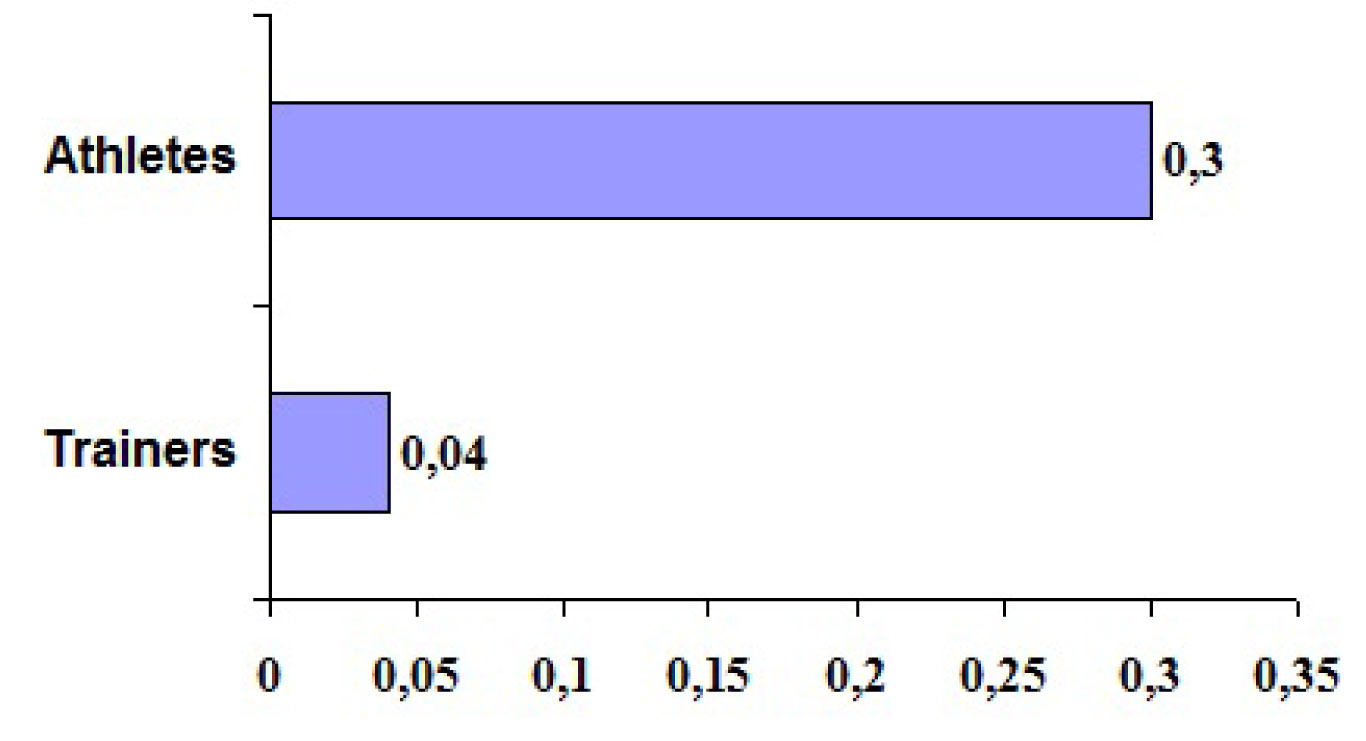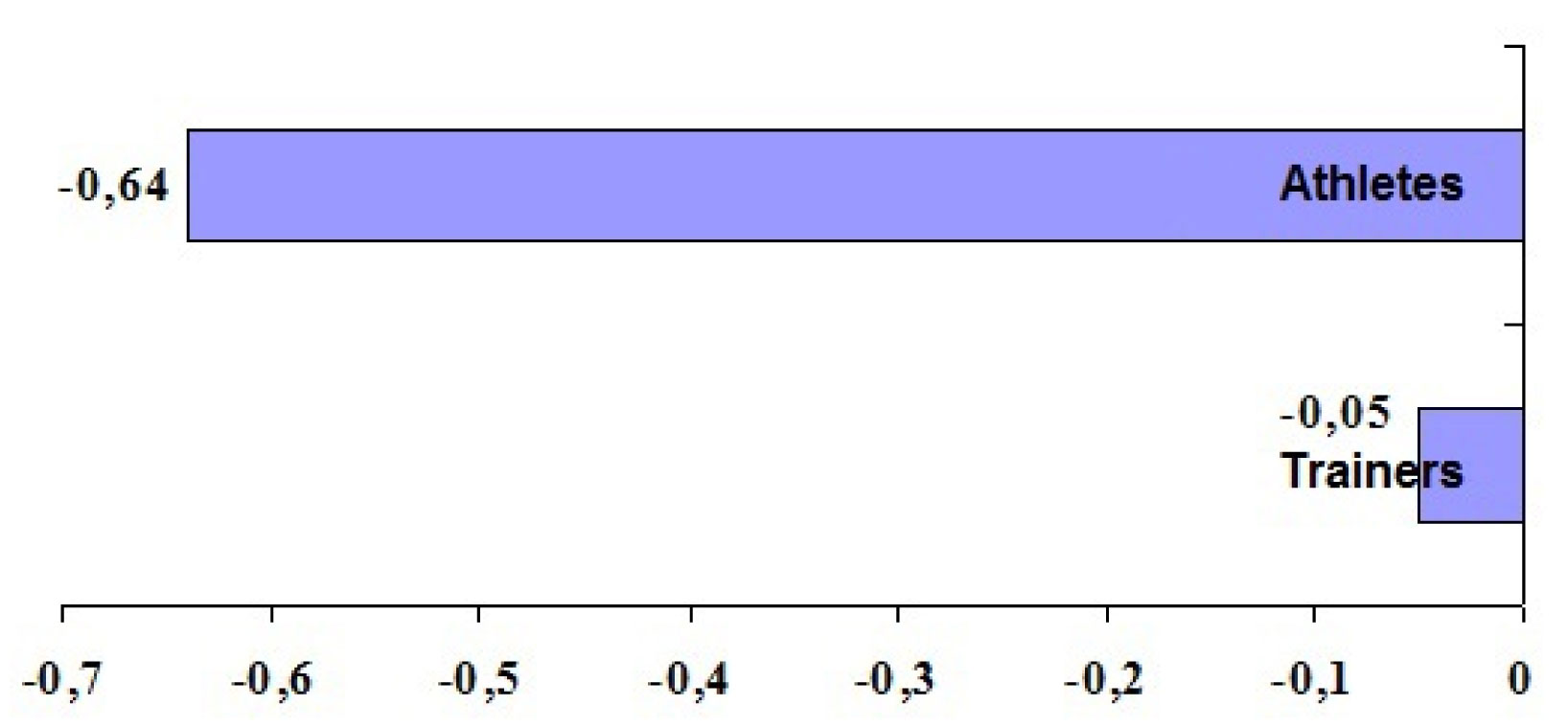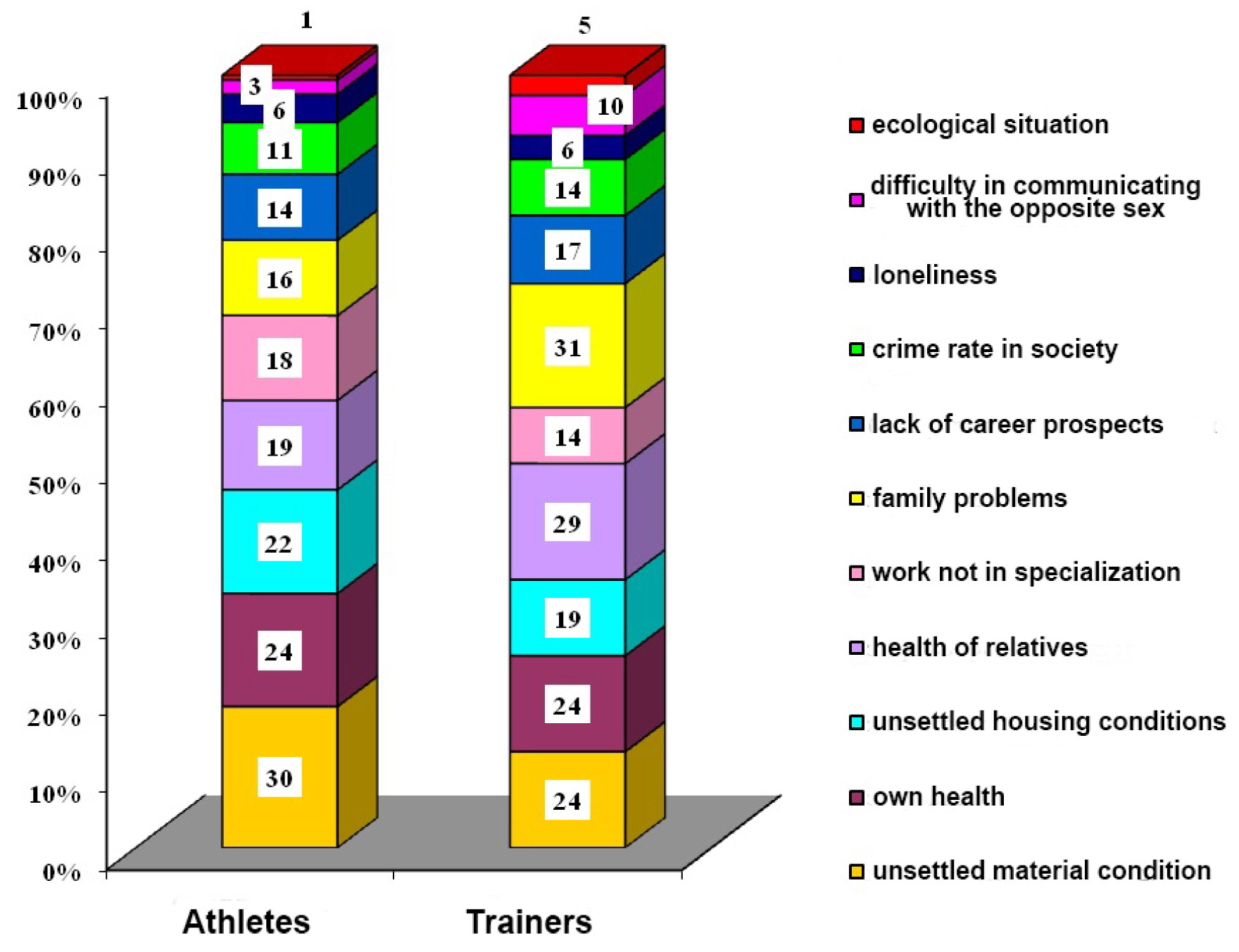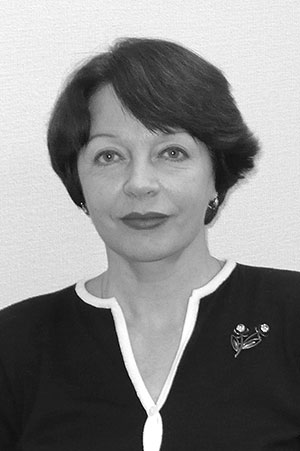Comparative Analysis of Psychosocial Factors of Professional Activity of Athletes and Trainers
Фотографии:
ˑ:
O.S. Kogan, professor, Dr.Med.
Bashkir Institute of Physical Culture, Ufa
Key words: factors, psychology, questionnaire, sociological analysis, professional athlete, trainer.
Special studies carried out in various laboratories throughout the world show conclusively that there cannot be found any professional activities which could be compared to training and competitive loads of modern sports by the level of physical and mental stress.
Reactions leading to fatigue, exhaustion and depletion of adaptive reserves of the body are more typical for professional athletes, whose activity is characterized by performance in intense competitions distinguished by long duration and exceptionally intense competition associated with excessive physical and psychoemotional loads, frequently not corresponding to their potentials [J. Wilmore, D.L. Costill, 2001; D.E. Taunton, 2002].
Many authors refer the combination of intense workout with hard work or study to the group of factors affecting athletes during their professional activity [G. Kerr, H. Minden, 1988].
For us it seems appropriate to allocate the group of psychosocial factors that affect professional athletes during their professional activity. What is meant here is the group of factors comprising the level of psychological readiness of an athlete for competitions, the occurrence of conflicts in interpersonal relationships with a trainer and within a team, high probability of development of psychological and behavioral disorders in athletes against the background of fierce competition and peculiarities of sport motivation, quality of athlete's life, as well as family and original ("home") team relationships and others [L.I. Lubysheva, 2001; O.A. Sirotin, V.I. Sivakov, 2001; V.N. Saninsky, 2002]. In the opinion of most of the authors, stronger physiological reaction to stress of an athlete's contributes to the higher chance of injury [D. Yukelson, S. Merphy, 2002; R.E. Smith, 1986].
The purpose of the study was to reveal the importance of psychosocial factors of professional sports activity for social groups of athletes and trainers.
Materials and methods. The study included an anonymous survey of 200 active professional athletes and 200 athletes who have changed to training work after finishing their career in elite sport. The specially designed questionnaire included 30 questions and 131 answer options. It was based on the questionnaire developed by WHO experts to solve problems in the field of occupational medicine on the importance of psychosocial factors for employees.
The social optimism level was assessed by the degree of satisfaction with life, family relationships and work. Along with other indicators, ranked by the four-point scale (answers like: “yes, I agree”, “partially agree”, “rather disagree” and “disagree”; or “excellent”, “good”, “satisfactory”, “bad”), its quantitative assessment was made using the dimensionless index, changing from minus one to plus one and calculated by the formula:
In = [(a – d) + (b-c)/2]/n,
where a - the number of respondents who answered the question positively ("yes, satisfied"), b - "partially satisfied", c - "rather dissatisfied", d - "no, dissatisfied", n - the number of individuals involved in the questionnaire survey.
Taking into account the purpose of the study and the need for obtaining comparable data, the questionnaire included 3 logical groups. The first group consisted of questions about the attitude to professional sports activity and estimation of social satisfaction with professional activity; the second one was related to domestic, family and personal life problems and issues of employment after finishing elite sports career and included questions about satisfaction with personal life, family and team relationships, wealth status and thoughts of job prospects after having been involved in elite sport; the third group was to determine the level of social security awareness, including evaluation of anxiety state caused by social problems, ways to resolve them, estimation of own health status, access to high-quality medical care, maintaining a healthy lifestyle, etc.
Results and discussion. The comparative analysis of the results of the questionnaire survey conducted among athletes and trainers determined significant differences in the respondents' personal views on a number of matters of principle, which also affected the successive group estimates. The fact that the athletes were proved to be more optimistic than the trainers may be considered as the more general description of the revealed discrepancies. Apparently, the reason for this is the age difference (5-10 years on the average), preceding experience (or lack of one), and probably more stable social situation in the country typical for the experience of relatively young professional athletes.
The most significant differences were registered when evaluating the practicability of the present system of sports training in the country: while a univocal answer of 65% of athletes to this question was "yes", the trainers were much more cautious, and only less than one fourth of them (23%) could agree on that. Nearly as much (21%) strongly disagreed with this statement, and another 27% inclined to the same opinion (their answer was "very unlikely"). There was also a considerable discrepancy in the group integral index of evaluation by the athletes and trainers (Fig. 1).

Figure 1. Group integral index of evaluation of practicability of the present training system for athletes
Iе is interesting, while answering the direct question "Are you satisfied with your lifestyle pattern?" the athletes and trainers' opinions were almost the same by the group integral indices - 0.24 and 0.25 accordingly, which indicates the conscious choice of sports career and rather deep commitment to it in the course of a lifetime.
The athletes and trainers were also unanimous while estimating the level of their social security, with that the group integral index was highly negative - minus 0.88: 99% of athletes and 89% of trainers have grounds to believe that the level of social security in professional sport in Russia is extremely low.
At the same time, we got essentially different answers to a number of questions that by their meaning were close to the life satisfaction concept.
Thus, while processing the answers to the question "How often are you in bad mood for no apparent reason?", the rate of the group integral index differed more than ten times: we got the positive answer to this question from 40% of the trainers and 16% of the athletes. And vice versa - 80% of athletes hardly ever feel so, while the similar percentage among the trainers does not exceed 48% (Figure 2).

Figure 2. Group integral index of answers to the question "How often are you in bad mood for no apparent reason?"
Professional athletes associate great expectations for future with their professional sports activity, whereas trainers, who are no longer involved in elite sport, have much way behind and apparently many unrealized targets. For example, in 45% of situations the athletes consider professional sport as a source of the worthy material support. It is only 28% of trainers who think so. Herewith, the "moral census" of an athlete's profession is slightly higher from the trainers' perspective: 65% of them believe that professional sport is a good career, however, only less than a half of athletes (49%) think the same.
In the meantime, it is the trainers, not the athletes, who are more concerned about sustainable employment of athletes after finishing their career in elite sport: 87% of them strongly believe that in this matter athletes need the government support, while only 75% of athlete agree with them.
Both trainers and athletes associate their concern about the future to a greater extent with the general social unrest (61% and 59% accordingly), although the percentage of trainers who consider the source of this concern to be personal life problems and workplace conflicts is higher (26% versus 10% of athletes and 25% vesus 18% accordingly).
As for the more detailed consideration of the specific factors determining the greatest concerns of athletes and trainers about the near future, their structure is similar. The leading positions belong to the problems of material support that are of immediate interest for 30% of athletes and 24% of trainers, health problems essential for nearly one in four athletes or trainers (24% in both groups, the attitude to health is considered in detail below), unsettled housing conditions (22% and 29% accordingly), health of relatives (of children and parents), which is certainly more essential for the group of trainers (19% and 29%), family problems that are almost in the similar ratio (16% and 31%), and job-related problems the importance of which as a whole is vital for 32% of athletes and 31% of trainers (Fig. 3).
Among the leading measures to help trainers master the anxiety are improvement of family relationships (26%), drastic changes in lifestyle (26%), acquisition of skills of mastering anxiety (26%) and increase in material welfare (25%). The above mentioned measures are also pertinent for athletes (significance range is between 16-22%), except for the skill to manage anxiety, importance of which was emphasized by 4% only. There is a relatively high - 14% - percentage of athletes who have no idea how to reduce anxiety.

Figure 3. Structure of crucial factors of concerns about near future for athletes and trainers, %
Among the reasons that impede the realization of the corresponding intents, the more significant is the absence of family and friends support, which was emphasized by 57% of athletes and 45% of trainers; it is followed by lack of money (36% and 25%) and time shortage (12% and 17%). Of special note are two groups of reasons that can be figuratively combined into: indisposition (apathy) and lack of self-confidence, - the significance of which as a whole amounts to 27% for athletes and 24% for trainers. For trainers management support is also important (24%), for athletes it is much less essential (9%).
It is worth mentioning that the so-called non-production psychosocial factors altogether are not at all crucial for athletes and trainers. Firstly, both are fully satisfied with their family relationships. However, the group integral index of satisfaction with family relationships among the trainers is slightly lower than that among the athletes: 0.66 versus 0.82, but in both groups it is significantly higher than the life satisfaction index. Not more than 20% of athletes and 30% of trainers are stressed out due to family conflicts and problems.
The athletes and trainers evaluated their housing conditions pretty much the same. According to the questionnaire, only one in five athletes and trainers has good accommodation where each family member has his own room, around half of them (53% of athletes and 51% of trainers) consider their accommodation to be satisfactory as each family member has not less than 9 m2 of floor-space, 20% of trainers and 2% of athletes possess residential space that does not comply with the minimal standard, and 8% of trainers and one in four athletes have no place to live at all. The integral index of the housing accommodation quality was 0.21 for athletes and 0.28 for trainers.
Conclusion. Athletes and trainers, who used to be in elite sport, refer professional sport to high-cost activity in terms of health. In addition, against the background of relatively high attractiveness of sports career, athletes and trainers consider their level of social security to be low, which, in their opinion, is displayed primarily in the inadequate level of medical care.
References
- Lubysheva, L.I. Sociology of physical education and sport / L.I. Lubysheva. – Moscow: Academia, 2001. – 240 P. (In Russian)
- Saninsky, V.N. Modern aspects of organizing and conducting the biomedical support of training of Russian national teams in Olympic sports / V.N. Saninsky // Profession and Health: Proceedings of the I All-Rus. congress (November, 19 - 21 2002, Moscow). – Moscow: Zlatograf, 2002. – P. 44-45. (In Russian)
- Sirotin, O.A. The effect of frustrating situations on the social adjustment of athletes to training and competitive activities / O.A. Sirotin, V.I. Sivakov // Teoriya i praktika fizicheskoy kultury. – 2001. – № 3. – P. 6-8. (In Russian)
- Wilmore, J. Physiology of sport / J. Wilmore, D.L. Costill. - Kiev.: Olimpiyskaya literatura, 2001. – 264 P. (In Russian)
- Taunton, D.E. Errors in the training process / D.E. Taunton / Sports injuries. - Kiev: Olimpiyskaya literatura, 2002. – P. 176-183. (In Russian)




 Журнал "THEORY AND PRACTICE
Журнал "THEORY AND PRACTICE